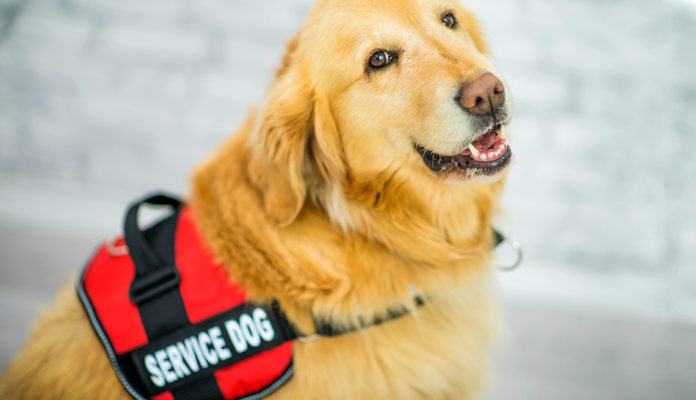“Is that a real service dog or is it really just your pet that you want to be able to take with you everywhere you go?” This is a question being asked quite a bit. More people than not love dogs. And dogs properly trained can help humans in many ways, making life for people with real disabilities easier and much more pleasant. But the increasing practice of pretending that a pet is actually a service dog or even an emotional support animal is becoming a problem, according to an online site called ‘Wide Open Pets’ which caters to pet owners and animal lovers and in a story written and posted by Paige Cerulli.
After hearing comments from several local business owners who had questions as to what the policy is on this issue, South Boston Today did some research into it in an effort to answer some of those questions and to pass along the information to our readers who might also be curious about it.
Often, trained and certified Service Dogs can be recognized by the special service dog vests they wear and also by ID tags. More often than not, these dogs have gone through years of rigorous training that give them the skills they need to properly assist the owners they are assigned to, who have specific disabilities which their dogs are geared to help with. True service dogs are trained to perform specific tasks for their humans. These dogs are also trained not to be distracted by their surroundings and to remain focused on the needs of their humans. Since service dogs are trained to help people in specific ways, and are highly trained to be passive, they are allowed to go into many public places where non-service dogs are never allowed, such as restaurants, airports etc.
Business owners and their employees are often unsure about how to deal with dogs being brought into their stores, especially if there are complaints by customers who disapprove of or feel uncomfortable or nervous about the presence of those dogs. In some cases, people have legitimate allergies to dogs. But the rules and regulations clearly state that workers at establishments that serve the public are allowed to ask only two questions which are ‘Is that a service dog?’ and ‘What service does the dog provide?’
The rising problem is that some people are passing off their pets as service animals, when they are actually not. And getting your dog certified as an ‘Emotional Support’ animal is becoming easier all the time, even though in many cases the animals don’t have anywhere near the training, if any at all, to be considered safe in public areas with people they don’t know or in areas where other animals are and aggressive behavior might take place. This can put real service dogs in danger of being attacked and nearby humans in harm’s way. While emotional support dogs also perform services in the cases of Post Traumatic Stress Disorder (PTSD), there are different requirements and benefits for their owners to have their dogs certified as an emotional support dog. To get more information on the differences in certification requirements you can go on the Americans with Disabilities Act website at www.ada.gov/service_animals_2010.htm .
That there is growing abuse by some people who deliberately mislead by trying to pass off their pets as legitimate service animals is undeniable, and it seems to be happing with ever increasing frequency. As one frustrated local business owner put it “What, if someone walks in here with a Bengal Tiger on a leash or a cursing parrot on their shoulder, I’m supposed to look the other way because the accompanying human insists that they have them for emotional support”? Good question. Of course those situations would be extreme cases and stranger things have happened, but not often, yet a good question just the same.
There are efforts being discussed regarding ways to curtail this practice, including the fines that go with committing these acts. In the meantime, experts on the matter believe it would be better for all involved, especially for people with true disabilities who need to have their service animals by their side when out in public and for the service animals themselves if everyone followed the rules and the practice of ‘faking it’ comes to an end.












